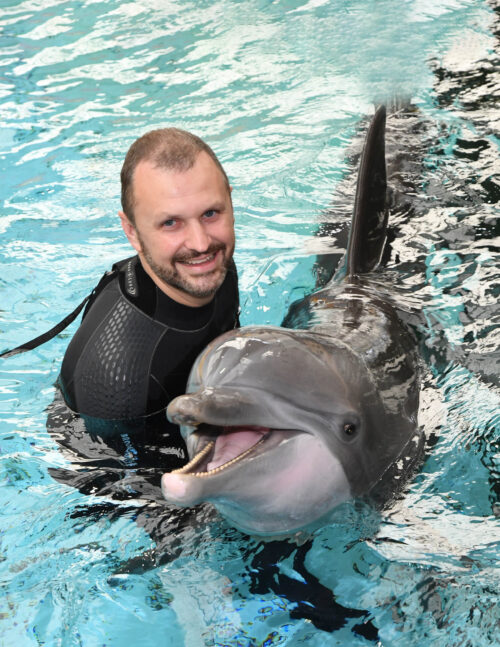New Brookfield Zoo Head Is Hands-On Leader in Animal World
By David A. F. Sweet
Soon after Dr. Michael Adkesson was tapped to be president and chief executive officer of the Chicago Zoological Society –whose Brookfield Zoo welcomes more than two million visitors annually — he needed to make a quick decision.
A meeting had been scheduled for the CEO, one of many in his new position. At the same time, a sinus problem in one of his former patients — a rhino named Layla — had returned and was blocking her ability to breathe comfortably. Since rhinos have difficulty breathing through their mouths, help was urgently needed.
The longtime animal doctor traded his suit for scrubs that morning to aid the 2,300-pound animal.
“We needed another set of veterinary hands,” explained Adkesson, who became only the third CEO in 45 years when he replaced Stuart Strahl in October. “You need 15-20 people on the ropes just to move her.”
Only seven months into his new job, Adkesson has already initiated ideas to introduce new animals to the sprawling 235-acre park, which before the pandemic enjoyed the distinction as the most visited paid tourist attraction in Chicago.
“I’ve been focusing our staff on adding some animals that are flashy and fun,” said Adkesson, who also serves as the director of Brookfield Zoo. “We’re looking at placing artificial trees where Mackaw parrots could be loud and eye-catching. We’re thinking of a prairie dog exhibit with acrylic tubes where kids could pop up in the prairie-dog world.”
Growing up in Decatur, Adkesson visited the zoo often.
“I fondly remember coming here and going to Tropic World,” he said. “The size and the height of it – you don’t see that other primate exhibits. The dolphins were also a favorite of mine.”
An internship at the zoo’s animal hospital in 2000 opened his eyes to the world of animals.
“That was my first real look at veterinary medicine beyond dogs and cats,” said Adkesson, who went on to earn a Doctor of Veterinary Medicine degree from the University of Illinois in 2004 before procuring a Master of Business Administration there in 2020. “I fondly recall examining a Ramar gorilla who had a tooth issue and providing care for a spider monkey named Kramer who had just received cataract surgery.”
After a stint as a veterinarian at the Saint Louis Zoo, Adkesson joined Brookfield for good in 2008. Four years later, he was chosen to oversee the veterinary programs and hospital operations there. He saw up close the amazing medical treatment the 500 species of animals received.
“The animals receive better care than billions of people in this world in developing nations,” he noted. “We provide phenomenal care and welfare.”
Adkesson stepped into his new position as the pandemic was winding down (save for an Omnicrom outbreak). Thanks in part to a $10 million campaign to keep the doors open — feeding and caring for all of the animals alone costs $41,000 a day — Brookfield emerged from Covid in stable financial condition.
But challenges remain. Speaking inside a building that opened in 1934, it’s no surprise one of the items Adkesson ticked off.
“We have older buildings that we need to renovate,” he said. “Tropic World was state of the art when it opened. But 40 years later, we view some things differently. We’re looking to put in outdoor habitats so the animals can feel the grass under their toes and the sunshine on their faces.”

“We’re looking to put in outdoor habitats so the animals can feel the grass under their toes and the sunshine on their faces,” says the new Chicago Zoological Society CEO.
There are a number of animals Adkesson would love to see at the zoo. Koala bears are one, and elephants – which used to be a big attraction there — are another, as long as they are financially viable.
“It’s hard to replicate the experience of seeing an elephant up close,” he said. “If we were to bring elephants back, we would want to house them in a dynamic environment where they are truly comfortable. We want to replicate how they live in the wild.”
Speaking of the wild, Adkesson has been heavily involved for more than 15 years in conservation work in South America. When he worked for the Saint Louis Zoo, he was asked to travel to Peru to study penguins. Though he expected to be finished after one trip, he fell in love with the wildlife reserve and the people. He kept returning and, since Brookfield Zoo has also been a supporting partner, continued his journeys once he was hired there. With thousands of Humboldt penguins, fur seals and sea lions, as well as hundreds of thousands of seabirds across 150 acres, “it’s the most important site in Peru for the conservation of these species,” he said.
In this era of Facebook and TikTok, many youngsters are content to see animals on screens rather than in person. Adkesson believes there is no digital replacement for engagement with wildlife. Said he, “Zoos provide that emotional connection.”
Unsung Gems columnist David A. F. Sweet is the author of Three Seconds in Munich. He can be reached at dafsweet@aol.com.









